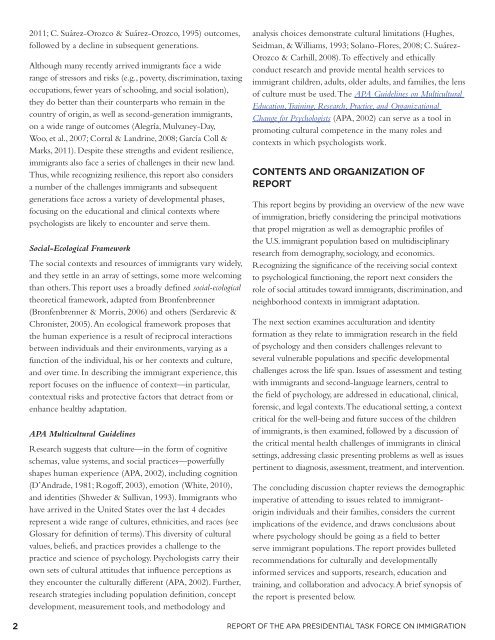Crossroads: The Psychology of Immigration in the New Century
Crossroads: The Psychology of Immigration in the New Century
Crossroads: The Psychology of Immigration in the New Century
Create successful ePaper yourself
Turn your PDF publications into a flip-book with our unique Google optimized e-Paper software.
2011; C. Suárez-Orozco & Suárez-Orozco, 1995) outcomes,<br />
followed by a decl<strong>in</strong>e <strong>in</strong> subsequent generations.<br />
Although many recently arrived immigrants face a wide<br />
range <strong>of</strong> stressors and risks (e.g., poverty, discrim<strong>in</strong>ation, tax<strong>in</strong>g<br />
occupations, fewer years <strong>of</strong> school<strong>in</strong>g, and social isolation),<br />
<strong>the</strong>y do better than <strong>the</strong>ir counterparts who rema<strong>in</strong> <strong>in</strong> <strong>the</strong><br />
country <strong>of</strong> orig<strong>in</strong>, as well as second-generation immigrants,<br />
on a wide range <strong>of</strong> outcomes (Alegría, Mulvaney-Day,<br />
Woo, et al., 2007; Corral & Landr<strong>in</strong>e, 2008; García Coll &<br />
Marks, 2011). Despite <strong>the</strong>se strengths and evident resilience,<br />
immigrants also face a series <strong>of</strong> challenges <strong>in</strong> <strong>the</strong>ir new land.<br />
Thus, while recogniz<strong>in</strong>g resilience, this report also considers<br />
a number <strong>of</strong> <strong>the</strong> challenges immigrants and subsequent<br />
generations face across a variety <strong>of</strong> developmental phases,<br />
focus<strong>in</strong>g on <strong>the</strong> educational and cl<strong>in</strong>ical contexts where<br />
psychologists are likely to encounter and serve <strong>the</strong>m.<br />
Social-Ecological Framework<br />
<strong>The</strong> social contexts and resources <strong>of</strong> immigrants vary widely,<br />
and <strong>the</strong>y settle <strong>in</strong> an array <strong>of</strong> sett<strong>in</strong>gs, some more welcom<strong>in</strong>g<br />
than o<strong>the</strong>rs. This report uses a broadly def<strong>in</strong>ed social-ecological<br />
<strong>the</strong>oretical framework, adapted from Bronfenbrenner<br />
(Bronfenbrenner & Morris, 2006) and o<strong>the</strong>rs (Serdarevic &<br />
Chronister, 2005). An ecological framework proposes that<br />
<strong>the</strong> human experience is a result <strong>of</strong> reciprocal <strong>in</strong>teractions<br />
between <strong>in</strong>dividuals and <strong>the</strong>ir environments, vary<strong>in</strong>g as a<br />
function <strong>of</strong> <strong>the</strong> <strong>in</strong>dividual, his or her contexts and culture,<br />
and over time. In describ<strong>in</strong>g <strong>the</strong> immigrant experience, this<br />
report focuses on <strong>the</strong> <strong>in</strong>fluence <strong>of</strong> context—<strong>in</strong> particular,<br />
contextual risks and protective factors that detract from or<br />
enhance healthy adaptation.<br />
APA Multicultural Guidel<strong>in</strong>es<br />
Research suggests that culture—<strong>in</strong> <strong>the</strong> form <strong>of</strong> cognitive<br />
schemas, value systems, and social practices—powerfully<br />
shapes human experience (APA, 2002), <strong>in</strong>clud<strong>in</strong>g cognition<br />
(D’Andrade, 1981; Rog<strong>of</strong>f, 2003), emotion (White, 2010),<br />
and identities (Shweder & Sullivan, 1993). Immigrants who<br />
have arrived <strong>in</strong> <strong>the</strong> United States over <strong>the</strong> last 4 decades<br />
represent a wide range <strong>of</strong> cultures, ethnicities, and races (see<br />
Glossary for def<strong>in</strong>ition <strong>of</strong> terms). This diversity <strong>of</strong> cultural<br />
values, beliefs, and practices provides a challenge to <strong>the</strong><br />
practice and science <strong>of</strong> psychology. Psychologists carry <strong>the</strong>ir<br />
own sets <strong>of</strong> cultural attitudes that <strong>in</strong>fluence perceptions as<br />
<strong>the</strong>y encounter <strong>the</strong> culturally different (APA, 2002). Fur<strong>the</strong>r,<br />
research strategies <strong>in</strong>clud<strong>in</strong>g population def<strong>in</strong>ition, concept<br />
development, measurement tools, and methodology and<br />
analysis choices demonstrate cultural limitations (Hughes,<br />
Seidman, & Williams, 1993; Solano-Flores, 2008; C. Suárez-<br />
Orozco & Carhill, 2008). To effectively and ethically<br />
conduct research and provide mental health services to<br />
immigrant children, adults, older adults, and families, <strong>the</strong> lens<br />
<strong>of</strong> culture must be used. <strong>The</strong> APA Guidel<strong>in</strong>es on Multicultural<br />
Education, Tra<strong>in</strong><strong>in</strong>g, Research, Practice, and Organizational<br />
Change for Psychologists (APA, 2002) can serve as a tool <strong>in</strong><br />
promot<strong>in</strong>g cultural competence <strong>in</strong> <strong>the</strong> many roles and<br />
contexts <strong>in</strong> which psychologists work.<br />
Contents and organization <strong>of</strong><br />
report<br />
This report beg<strong>in</strong>s by provid<strong>in</strong>g an overview <strong>of</strong> <strong>the</strong> new wave<br />
<strong>of</strong> immigration, briefly consider<strong>in</strong>g <strong>the</strong> pr<strong>in</strong>cipal motivations<br />
that propel migration as well as demographic pr<strong>of</strong>iles <strong>of</strong><br />
<strong>the</strong> U.S. immigrant population based on multidiscipl<strong>in</strong>ary<br />
research from demography, sociology, and economics.<br />
Recogniz<strong>in</strong>g <strong>the</strong> significance <strong>of</strong> <strong>the</strong> receiv<strong>in</strong>g social context<br />
to psychological function<strong>in</strong>g, <strong>the</strong> report next considers <strong>the</strong><br />
role <strong>of</strong> social attitudes toward immigrants, discrim<strong>in</strong>ation, and<br />
neighborhood contexts <strong>in</strong> immigrant adaptation.<br />
<strong>The</strong> next section exam<strong>in</strong>es acculturation and identity<br />
formation as <strong>the</strong>y relate to immigration research <strong>in</strong> <strong>the</strong> field<br />
<strong>of</strong> psychology and <strong>the</strong>n considers challenges relevant to<br />
several vulnerable populations and specific developmental<br />
challenges across <strong>the</strong> life span. Issues <strong>of</strong> assessment and test<strong>in</strong>g<br />
with immigrants and second-language learners, central to<br />
<strong>the</strong> field <strong>of</strong> psychology, are addressed <strong>in</strong> educational, cl<strong>in</strong>ical,<br />
forensic, and legal contexts. <strong>The</strong> educational sett<strong>in</strong>g, a context<br />
critical for <strong>the</strong> well-be<strong>in</strong>g and future success <strong>of</strong> <strong>the</strong> children<br />
<strong>of</strong> immigrants, is <strong>the</strong>n exam<strong>in</strong>ed, followed by a discussion <strong>of</strong><br />
<strong>the</strong> critical mental health challenges <strong>of</strong> immigrants <strong>in</strong> cl<strong>in</strong>ical<br />
sett<strong>in</strong>gs, address<strong>in</strong>g classic present<strong>in</strong>g problems as well as issues<br />
pert<strong>in</strong>ent to diagnosis, assessment, treatment, and <strong>in</strong>tervention.<br />
<strong>The</strong> conclud<strong>in</strong>g discussion chapter reviews <strong>the</strong> demographic<br />
imperative <strong>of</strong> attend<strong>in</strong>g to issues related to immigrantorig<strong>in</strong><br />
<strong>in</strong>dividuals and <strong>the</strong>ir families, considers <strong>the</strong> current<br />
implications <strong>of</strong> <strong>the</strong> evidence, and draws conclusions about<br />
where psychology should be go<strong>in</strong>g as a field to better<br />
serve immigrant populations. <strong>The</strong> report provides bulleted<br />
recommendations for culturally and developmentally<br />
<strong>in</strong>formed services and supports, research, education and<br />
tra<strong>in</strong><strong>in</strong>g, and collaboration and advocacy. A brief synopsis <strong>of</strong><br />
<strong>the</strong> report is presented below.<br />
2 Report <strong>of</strong> <strong>the</strong> APA Presidential Task Force on <strong>Immigration</strong>
















